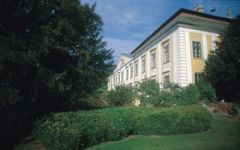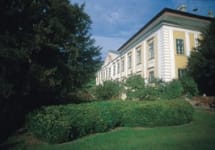Schloss Gobelsburg Schlosskellerei Cistercien Rose 2021



Product Details
Your Rating
Somm Note
Winemaker Notes
For the Cistercien Rosé, the Zweigelt and St. Laurent grape varieties grown in the cooler sites of Gobelburg and Langenlois are used. After the harvest, the grapes – still with their stems – are softly pressed and then fermented. This type of rosé is somewhat similar to a white wine because no acid reduction is used to emphasise the fine fruity character with a streamlined elegance. Its fragrance and fruit nuances of wild cherry and fresh berries make this Rosé an optimal universal food companion.
Other Vintages
2022-
Wine
Enthusiast


The Zwettl Monastery was founded in 1074 and in 1171 the Monks of Zwettl were granted their first vineyards: Heiligenstein & Gaisberg–the oldest documented sites in the Kamptal. The estate and Castle Gobelsburg was controlled by as many as 19 different families between 1074 and 1740, and in 1786 absorbed the famous Kammern Winery and vineyards. Two hundred years later Eva and Michael Moosbrugger were granted the winemaking and viticulural contract in 1996, and with the help and guidance of Michael’s mentor Willi Bründlmayer, the winery has regained its prestige and considered to be a leader in quality and innovation. In 2006 Michael Moosbrugger was awarded as ‘WINEMAKER OF THE YEAR’ by the Austrian magazine Falstaff, the highest award given to an Austrian winemaker, and in 2009 and 2010 the estate was acknowledged as ‘ONE OF THE TOP 100 WINERIES OF THE YEAR’ by Wine & Spirits Magazine.
Schloss Gobelsburg maintains a large number of parcels in Erste Lagen, or 1st Growth, vineyards in the Kamptal, including the mineral-rich, crystalline slopes of the Gaisberg and Heiligenstein planted to Riesling, and the deep loess soils of Renner, Grub, and Lamm planted to Grüner Veltliner. The winery continues to utilize organic winegrowing and has benefited from the fact that the monks of Zwettl Monastery began these practices as early as 1958.
While many international cellars are attempting to produce clean, uniform wines, Moosbrugger is convinced that the future Gobelsburg lies in individuality and character. As a high level of technology is necessary to warrant uniformity, Moosbrugger believes that individuality can only be achieved through the reduction of machines. Moosbrugger developed the ‘Dynamic Cellar Concept’ for Gobelsburg in which wines are no longer pumped from one location to the other, but transported in ‘barrels on wheels’ from one section of the cellar to the other.
A hallmark of the estate are the ‘Tradition’ bottlings of Grüner Veltliner and Riesling. Having read the meticulous notations of the Cistercians at the estate over the past 150 years, Michi pays homage in his role as cellar master, responsible for the ‘education’ of his ‘pupils’ –wine- while leading them through elevage; as opposed to acting as ‘winemaker,’ whose decisions in present day Austria are generally to preserve aromatics and fruit through extremely reductive methods.

Whether it’s playful and fun or savory and serious, most rosé today is not your grandmother’s White Zinfandel, though that category remains strong. Pink wine has recently become quite trendy, and this time around it’s commonly quite dry. Since the pigment in red wines comes from keeping fermenting juice in contact with the grape skins for an extended period, it follows that a pink wine can be made using just a brief period of skin contact—usually just a couple of days. The resulting color depends on grape variety and winemaking style, ranging from pale salmon to deep magenta.

Climbing north and slightly east of the Kremstal region, Kamptal has very little vineyard area bordering the Danube River (unlike Wachau and Kremstal, whose vineyards run along it). The region takes its name from the river called Kamp, which traverses it north and south. Kamptal’s densely planted vineyards represent eight percent of Austria’s total.
The area experiences wide diurnal temperature variations like the Wachau but with less rain and more frost. Its vast geologic diversity makes it suitable for various experimentations with other varieties besides Grüner Veltliner and Riesling, such as Chardonnay, Pinot Blanc (Weissburgunder), Sauvignon Blanc, Pinot Noir, St. Laurent and Zweigelt.
But the region is probably most noted for the beautiful and expansive terraced Heiligenstein, arguably one of the world’s top Riesling sites, as well as some of Austria’s most extraordinary Grüner Veltliner vineyards. Kamptal’s soils, which are mostly loess and sand with some gravel and rocks, make it suitable for Grüner Veltliner, so much so that actually half of the zone is planted to that grape.
